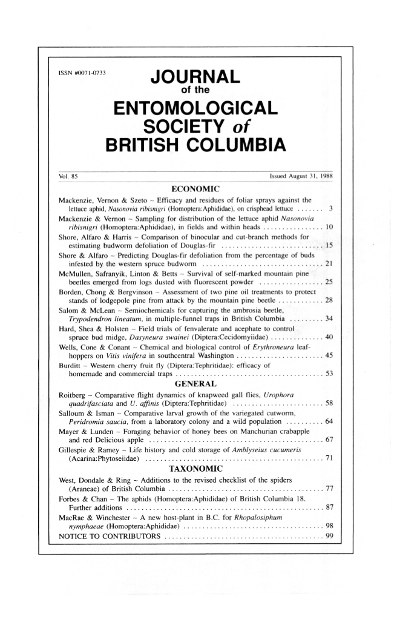Comparison of Binocular and Cut-branch Methods for Estimating Budworm Defoliation of Douglas-fir
Abstract
Defoliation caused by the western spruce budworm , Choristneura occidentalis Freeman, was estimated on 91 Douglas-fir trees Pseudotsuga menziesii var. glauca (Beissn.) Franco, by both close examination of cut -branches and by observation with binoculars. For individual trees the accuracy attained with the binoculars was within 23% for current year's and 19% for foliage of all ages , with respect to the estimates made from cut branches. Inaccuracy was found to be mainly due to lack of precision as bias was minimal. When the trees were assigned. by each method , into the broad de foliation classes of light ( 1-25%). moderate (26-65%), and severe (66- 100%). as used in forest insect surveys in British Columbia. the results agreed in 89% of the trees studied for defoliation estimates of current foliage and 68% of the trees for defoliation of total foliage. Classification of the location averages into severity classes agreed for all 5 locations studied for damage to current and total foliage. We concluded that the binocular method is a quick and useful means of classifying stands into broad defoliation severity classes. but is not suitable if a high degree of accuracy and precision is needed.Downloads
Issue
Section
License
Authors who publish with the Journal of the Entomological Society of British Columbia agree to the following terms:
-Authors retain copyright and grant the journal right of first publication with the work simultaneously licensed under a Creative Commons Attribution License that allows others to share the work with an acknowledgement of the work's authorship and initial publication in this journal.
-Authors are able to enter into separate, additional contractual arrangements for the non-exclusive distribution of the journal's published version of the work (e.g., post it to an institutional repository or publish it in a book), with an acknowledgement of its initial publication in this journal.
-Authors are permitted and encouraged to post their work online (e.g., in institutional repositories or on their website) prior to and during the submission process, as it can lead to productive exchanges, as well as earlier and greater citation of published work (See The Effect of Open Access).


